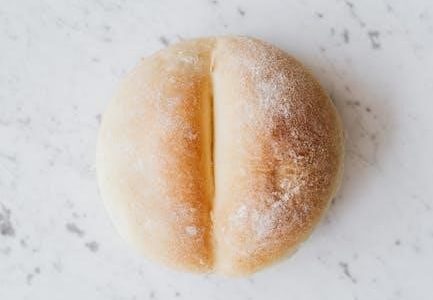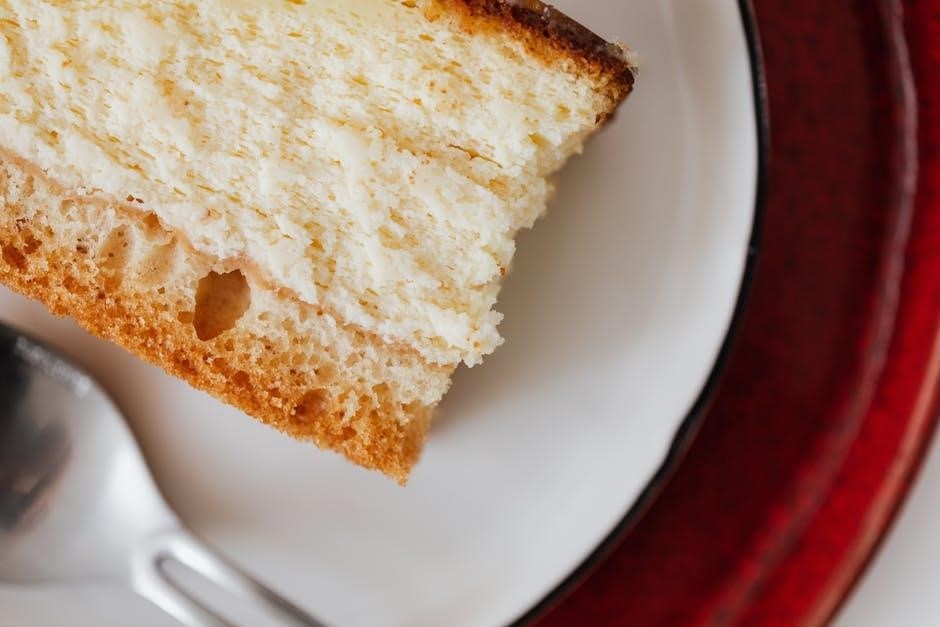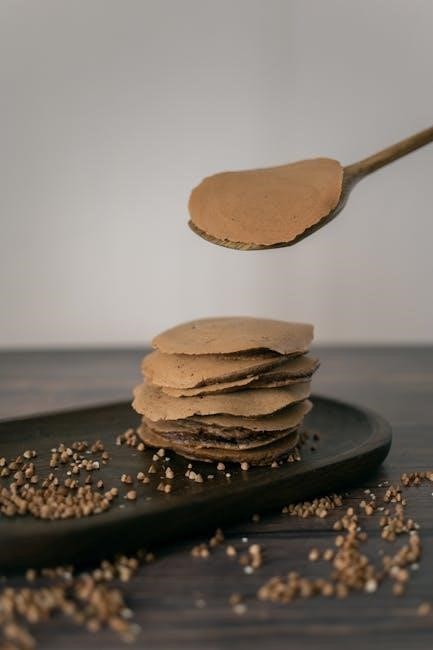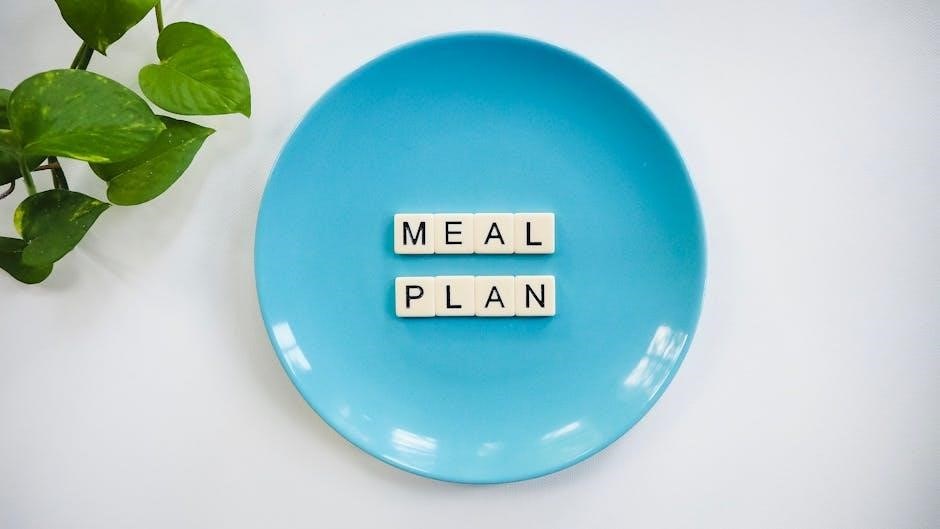
1600 calorie meal plan pdf
A 1600-calorie meal plan is designed for weight loss and fat reduction through a controlled calorie deficit. It focuses on balanced nutrition and nutrient-dense foods to support overall health while promoting a sustainable eating pattern tailored to individuals with lower caloric needs‚ such as women or those with lower activity levels.

What is a 1600 Calorie Meal Plan?
A 1600-calorie meal plan is a structured eating plan designed to help individuals manage their daily calorie intake for weight loss or maintenance. It typically involves carefully portioned meals and snacks that add up to approximately 1600 calories per day. This plan is often tailored to meet the nutritional needs of those with lower caloric requirements‚ such as women or individuals with a less active lifestyle. The plan emphasizes balanced nutrition‚ focusing on nutrient-dense foods like lean proteins‚ whole grains‚ fruits‚ and vegetables‚ while keeping track of macronutrient distribution to ensure overall health and satisfaction. It is usually flexible enough to accommodate personal preferences and dietary goals‚ making it a sustainable option for those aiming to lose weight or improve their eating habits;
Who is the 1600 Calorie Meal Plan Suitable For?
The 1600-calorie meal plan is ideal for individuals seeking weight loss or improved nutrition‚ particularly women or those with lower caloric needs. It suits sedentary to lightly active people‚ as well as those aiming for fat loss while maintaining muscle mass. This plan is also suitable for individuals who require a structured yet flexible eating pattern to stay on track with their dietary goals. It is often recommended for those who need guidance on portion control and balanced nutrition‚ ensuring they meet their nutritional requirements without overeating. A 1600-calorie plan is typically designed by dietitians to cater to specific health and fitness objectives;

Benefits of a 1600 Calorie Meal Plan
A 1600-calorie meal plan promotes weight loss‚ improves nutritional balance‚ and increases energy levels. It supports fat reduction while ensuring essential nutrients are met for overall health and wellness.
Weight Loss and Fat Reduction
A 1600-calorie meal plan is effective for weight loss by creating a calorie deficit‚ essential for fat reduction. It helps burn stored fat while maintaining muscle mass‚ especially when combined with protein-rich foods and regular physical activity. The plan promotes a steady weight loss of 1-2 pounds per week‚ supporting long-term fat reduction goals; By focusing on nutrient-dense meals‚ it ensures satiety‚ reducing the likelihood of overeating and cravings. Consistency with this plan‚ paired with a balanced diet‚ can lead to significant fat loss and improved body composition over time. Consulting a dietitian ensures the plan is tailored for sustainable results.
Improved Nutritional Balance
A 1600-calorie meal plan emphasizes balanced nutrition by incorporating a variety of nutrient-dense foods. It focuses on whole grains‚ lean proteins‚ fruits‚ and vegetables to ensure adequate vitamins and minerals. This approach helps maintain energy levels and supports overall health. The plan encourages mindful eating and portion control‚ promoting better food choices. By prioritizing quality over quantity‚ it teaches sustainable eating habits that can be maintained long-term. Regularly tracking meals and consulting a dietitian helps tailor the plan to individual needs‚ ensuring a balanced intake of carbs‚ proteins‚ and fats while keeping calorie intake in check for optimal health benefits.
Increased Energy Levels
A 1600-calorie meal plan can boost energy levels by providing a balanced intake of nutrients essential for bodily functions. This plan focuses on whole‚ nutrient-dense foods like whole grains‚ lean proteins‚ and healthy fats‚ which offer sustained energy. By avoiding excessive sugar and processed foods‚ energy fluctuations are minimized‚ promoting stable vitality throughout the day. Incorporating iron-rich foods‚ B vitamins‚ and complex carbs supports metabolic health and reduces fatigue. Proper hydration and regular meals further enhance energy levels‚ ensuring the body functions optimally even with a calorie-restricted diet.

How to Create a 1600 Calorie Meal Plan
Creating a 1600-calorie meal plan involves setting a daily caloric goal‚ balancing macronutrients‚ and planning meals with portion control. Start by determining your caloric needs and deficit for weight loss. Divide the calories into three main meals and snacks‚ focusing on nutrient-dense foods like lean proteins‚ whole grains‚ fruits‚ and vegetables. Use measuring tools to ensure accurate portion sizes. Consider meal prepping to stay on track and maintain variety to avoid boredom. Plan grocery shopping and cooking in advance‚ and track progress with a food diary to monitor success and make adjustments as needed.
Understanding Caloric Needs and Deficits
Understanding your caloric needs and deficits is crucial for designing an effective 1600-calorie meal plan. Caloric needs vary based on factors like age‚ weight‚ height‚ and activity level. A caloric deficit occurs when you consume fewer calories than your body burns‚ promoting weight loss. For most adults‚ a daily deficit of 500 calories can lead to a safe weight loss of 1 pound per week. A 1600-calorie plan is often suitable for those with lower energy needs or smaller frames. However‚ individual needs may differ‚ so consulting a dietitian to tailor the plan is recommended for optimal results and sustainability.
Macronutrient Breakdown: Carbs‚ Proteins‚ and Fats
A balanced 1600-calorie meal plan typically allocates 45-55% of calories to carbohydrates‚ 30-35% to protein‚ and 20-25% to fats. Carbohydrates provide energy‚ with whole grains‚ fruits‚ and vegetables being ideal sources. Proteins are essential for muscle repair and satiety‚ with lean meats‚ fish‚ eggs‚ and legumes being excellent options. Healthy fats‚ such as avocados‚ nuts‚ and olive oil‚ support heart health and hormone production. This macronutrient distribution ensures nutritional balance while promoting weight loss and overall well-being within the calorie-restricted framework.
Meal Planning Strategies
Effective meal planning is crucial for a successful 1600-calorie diet. Start by setting clear goals and identifying your dietary preferences. Plan meals weekly to ensure variety and avoid repetition. Create a grocery list to stay on track and avoid impulse purchases. Prioritize cooking at home using fresh ingredients to control calorie and nutrient intake. Schedule meal prep sessions to save time during busy days. Incorporate leftovers to reduce waste and maintain consistency. Adjust portion sizes based on hunger levels and activity‚ ensuring meals are satisfying yet calorie-appropriate. This structured approach helps maintain adherence and makes the diet more sustainable long-term.

Sample Daily Meal Plan
A balanced 1600-calorie daily plan includes breakfast‚ lunch‚ dinner‚ and snacks‚ focusing on lean proteins‚ whole grains‚ and vegetables to meet nutritional needs while controlling calories.
Breakfast Options
Start your day with nutrient-rich breakfasts like oatmeal with berries and nuts‚ scrambled eggs with spinach‚ or Greek yogurt with honey and chia seeds. These options provide a balance of protein‚ fiber‚ and healthy fats to keep you full; A veggie omelet with whole-grain toast or a smoothie with spinach‚ banana‚ and almond milk are also great choices. Portion control is key to staying within your calorie goals. Aim for meals that combine lean proteins‚ whole grains‚ and colorful vegetables to fuel your morning without excess calories.
Lunch Ideas
For a satisfying midday meal‚ consider options like grilled chicken salads with mixed greens‚ cherry tomatoes‚ and a light vinaigrette‚ or whole-grain wraps with turkey breast‚ avocado‚ and veggies. Quinoa bowls with roasted vegetables and a lemon-tahini dressing are also nutritious choices. Soups‚ such as lentil or vegetable broth with lean ground beef‚ can be filling and low in calories. Pair these with a side of steamed vegetables or a small portion of whole grains. Aim for meals that are balanced‚ flavorful‚ and portion-controlled to support your weight loss goals while keeping you energized throughout the afternoon.
Dinner Recipes

Dinner options should be light yet satisfying‚ focusing on protein and vegetables. Grilled salmon with a side of asparagus and quinoa is a nutrient-rich choice. Chicken stir-fries with broccoli‚ bell peppers‚ and brown rice are also ideal. For vegetarian options‚ try stuffed bell peppers with lean ground turkey‚ beans‚ and low-fat cheese. Baked cod with roasted Brussels sprouts and sweet potatoes offers a balanced meal. Ensure portions are controlled and ingredients are fresh. These recipes provide essential nutrients while keeping calories in check‚ supporting both weight loss and overall health within a 1600-calorie plan.
Snacks and Desserts
Snacks and desserts should be low in calories but satisfying. Fresh fruit like berries or citrus is an excellent choice. A small handful of nuts or a yogurt parfait with granola can curb hunger. For desserts‚ opt for dark chocolate squares (at least 70% cocoa) or homemade fruit sorbet. Protein-based snacks like hard-boiled eggs or a slice of avocado toast are also great. Portion control is key to staying within daily calorie goals. These options provide nutrients and flavor without compromising weight loss efforts‚ ensuring a balanced and enjoyable 1600-calorie meal plan.

Common Challenges and Solutions
- Hunger and cravings: Incorporate protein-rich snacks and fiber to stay full.
- Meal prep challenges: Plan meals weekly and shop accordingly to avoid last-minute decisions.
- Hydration: Drink water before meals to reduce hunger and support digestion.
Handling Hunger and Cravings
Handling hunger and cravings on a 1600 calorie meal plan requires strategic planning. Incorporate protein-rich foods like eggs‚ lean meats‚ and legumes to keep you full longer. Fiber from vegetables and whole grains also helps suppress hunger. Healthy snacks‚ such as nuts or fruit‚ can curb cravings without exceeding calorie limits. Staying hydrated is crucial‚ as thirst is often mistaken for hunger. Eating mindfully and avoiding distractions during meals can reduce overeating. Lastly‚ include small portions of nutrient-dense treats to satisfy cravings while staying within your calorie goal.
Meal Prepping Tips
Meal prepping is essential for sticking to a 1600 calorie meal plan. Start by planning your meals for the week‚ ensuring each dish aligns with your calorie and nutrient goals. Shop for ingredients in bulk to save time and money. Dedicate one day to prepare meals‚ portioning them into containers for easy grab-and-go access. Focus on balance by including a variety of proteins‚ vegetables‚ and whole grains. Store prepped meals in airtight containers to maintain freshness. Label and date each meal to avoid confusion. Reuse leftovers creatively to reduce waste and keep things exciting. Consider prepping healthy snacks to prevent impulsive eating.

Optimizing Nutrition in a 1600 Calorie Diet

Prioritize nutrient-dense foods like lean proteins‚ whole grains‚ and colorful vegetables to maximize nutritional value. Incorporate healthy fats and fiber-rich foods to enhance satiety and overall health benefits.
Focus on Nutrient-Dense Foods
In a 1600-calorie meal plan‚ prioritize nutrient-dense foods to ensure adequate nutrition. Include a variety of vegetables‚ lean proteins‚ whole grains‚ and healthy fats. Dark leafy greens‚ berries‚ and citrus fruits provide essential vitamins and antioxidants. Incorporate legumes‚ nuts‚ and seeds for fiber and minerals. Opt for whole grains like quinoa‚ brown rice‚ and oats to maintain energy levels. Lean proteins such as chicken‚ fish‚ and tofu support muscle health. Healthy fats like avocados and olive oil enhance meal satisfaction and digestion. Aim for colorful‚ diverse meals to cover all nutritional bases without exceeding calorie limits.
Hydration and Its Role in Weight Loss
Adequate hydration is crucial for weight loss on a 1600-calorie meal plan. Water supports metabolism‚ aiding in the breakdown of nutrients and fat. Even mild dehydration can slow metabolism and reduce energy levels. Drinking water before meals can suppress appetite‚ helping control portion sizes. Aim for at least 8 cups (64 ounces) of water daily. Incorporate hydrating foods like cucumbers‚ melons‚ and broth-based soups. Herbal teas and low-calorie drinks also contribute to hydration without adding calories. Staying hydrated enhances digestion‚ reduces bloating‚ and supports overall health‚ making it easier to stick to your calorie goals and achieve sustainable weight loss.
Mindful Eating Practices
Mindful eating is a powerful tool for weight loss and overall well-being. It involves paying full attention to the experience of eating‚ savoring flavors‚ and listening to your body’s hunger cues. This practice helps reduce overeating and promotes satisfaction with smaller portions; Eat slowly‚ avoid distractions like screens‚ and focus on the texture‚ taste‚ and smell of your food. Stop when you feel satisfied‚ not stuffed. Mindful eating also encourages healthier choices‚ fostering a positive relationship with food. By being present during meals‚ you can better manage cravings and maintain adherence to your 1600-calorie meal plan.

Tracking Progress
Monitor your weight loss journey by tracking meals‚ physical activity‚ and progress photos. Regular weigh-ins and food diary updates help maintain accountability and motivation. Stay consistent!
Using a Food Diary
A food diary is a powerful tool for tracking your daily meals and calorie intake. By documenting each meal‚ snack‚ and beverage‚ you can monitor your progress and ensure you stay within your 1600-calorie goal. Include details like portion sizes‚ ingredients‚ and approximate calorie counts for accuracy. Over time‚ this diary will help identify patterns‚ such as overeating or nutrient deficiencies‚ allowing for adjustments. Digital apps or physical notebooks work well—choose what suits you best. Consistent use of a food diary fosters accountability and helps maintain motivation‚ making it easier to achieve your weight loss and health objectives.
Monitoring Weight Loss
Monitoring weight loss on a 1600-calorie meal plan involves regular tracking to ensure progress. Start with weekly weigh-ins on the same day and time for consistency. Use a scale to measure weight and track changes over time. Additionally‚ take body measurements to assess fat loss and muscle retention. Progress photos can also help visualize improvements. Track how your clothes fit and energy levels‚ as these indicators often show positive changes before the scale reflects them. Adjust your plan if weight loss stalls‚ ensuring you stay on course. Consistency and patience are key—celebrate small milestones to stay motivated and focused on your goals.
A 1600-calorie meal plan promotes sustainable weight loss and improved health when followed consistently. Celebrate small milestones‚ stay patient‚ and consult a dietitian for personalized adjustments.
The Importance of Consistency
Consistency is key to achieving success with a 1600-calorie meal plan. Sticking to your daily caloric goals ensures a steady metabolic rate and gradual weight loss. Regular eating patterns help regulate hunger hormones and portion control. Over time‚ consistent habits foster a healthier relationship with food‚ making it easier to sustain long-term results. Even small deviations can impact progress‚ so staying committed is crucial. Incorporate meal prepping and tracking to maintain consistency‚ especially during busy days. Remember‚ consistency breeds habit‚ and habits lead to lasting transformation in your health and physique.
Consulting a Dietitian for Personalization
Consulting a dietitian can elevate your 1600-calorie meal plan by tailoring it to your specific needs‚ lifestyle‚ and health goals. A registered dietitian assesses your unique requirements‚ such as activity levels‚ medical conditions‚ and dietary preferences‚ to create a personalized plan. This ensures balanced nutrition and maximizes weight loss results. They can also address special needs‚ like allergies or vegetarian preferences‚ and provide strategies to maintain long-term sustainability. By working with a dietitian‚ you gain professional guidance to overcome challenges and adjust your plan as needed‚ ensuring it remains effective and adaptable to your evolving health journey.